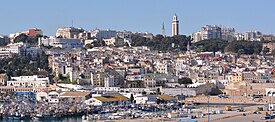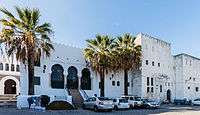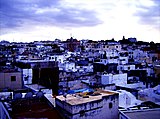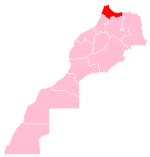Tangier
Tangier
طنجة | |
|---|---|
Clockwise from top: View towards the Medina, courtyard of Kasbah Palace, waterfront from Achakar, Cape Spartel lighthouse | |
|
UTC+1 (CET) | |
| Postal codes |
|
| Area code | 0539 |
| Website | tanger |
| |
Tangier (
Many civilisations and cultures have influenced the history of Tangier, starting from before the 10th century BCE. Starting as a strategic
By the early 21st century, Tangier was undergoing rapid development and modernisation. Projects include tourism projects along the bay, a modern business district called Tangier City Centre, an airport terminal, and a football stadium. Tangier's economy is set to benefit greatly from the
Names
The
Moroccan historian
Tangier was formally known as Colonia Julia Tingi ("The
History
Ancient
Tangier was founded as a
The Greeks knew this town as
Tingis came under the control of the
Tingis received certain municipal privileges under
Medieval

Probably invited by
Tingis was reconquered by
Under the
The
The
Like Ceuta, Tangier did not initially acknowledge the
The next century was an obscure time of rebellions and difficulties for the city. During this time, the traveler
Early modern
When the Portuguese started their

Iberian rule lasted until 1661,
The English took advantage of the respite to improve greatly the Portuguese defences.
An attempt by Sultan Moulay Ismail of Morocco to seize the town in 1679 was unsuccessful; but longstanding exasperation with the colony's finances[47] and a crippling blockade by Jaysh al-Rifi[citation needed] pushed Parliament to write off the effort in 1680.[47] At the time, Tangier's population consisted of only about 700 apart from the thousand-man garrison; Governor Kirke estimated 400 of them had suffered gonorrhea from the same "mighty pretty" sex worker.[47] Forces under Lord Dartmouth (including Samuel Pepys) methodically destroyed the town and its port facilities for five months prior to Morocco's occupation of the city on 7 February 1684.[48]
Ali ibn Abdallah and his son Ahmed ibn Ali served in turn as the town's governors until 1743, repopulating it with populace from the surrounding countryside.[49] They were powerful enough to oppose Sultan Abdallah through his various reigns, giving support and asylum to his various rivals within and without the royal family.[50]
The Spanish attacked the city in 1790[16] but the city grew until, by 1810, its population reached 5,000.
Internationalisation


From the 18th century, Tangier served as Morocco's diplomatic headquarters.
In 1828,
Italian revolutionary hero
Tangier's geographic location made it a center of
Improved harbour facilities were completed in 1907, with an inner and outer
In 1912, the
The Tangier International Zone was created under the joint administration of France, Spain and the United Kingdom by an international convention signed in Paris on 18 December 1923.[61] Ratifications were exchanged in Paris on 14 May 1924, and the convention was registered in League of Nations Treaty Series on 13 September 1924.[62] It was amended by a protocol of July 1928 to elevate the status of Italy, an idea put forth by Sir Austen Chamberlain of Great Britain.[63] The European powers' creation of the statute of Tangier promoted the formation of a cosmopolitan society where Muslims, Christians, and Jews lived together with reciprocal respect and tolerance. A town where men and women, with many different political and ideological tendencies, found refuge, including Spaniards from the right or from the left, Jews fleeing Nazi Germany and Moroccan dissidents. With very liberal economic and fiscal laws, Tangier became - in an international environment full of restrictions, prohibitions and monopolies - a tax haven with absolute freedom of trade.[64] The International Zone of Tangier had a 373 km2 (144 sq mi) area and, by the mid-1930s, a population of about 50,000 inhabitants: 30,000 Muslims; 12,000 Jews; and 8,000-odd Europeans, with a decreasing proportion of working-class Spaniards.[15]
Spanish troops occupied Tangier on 14 June 1940, the same day
Moroccan independence
The Tangier International Zone played an important role in the campaign for Moroccan independence.[68] Because of its legal status as an international zone, activists were able to meet in Tangier, relatively protected from the French and Spanish authorities.[68] In 1951, the National Front was created in Tangier, a pact between Morocco's four nationalist parties to coordinate their campaign to achieve Moroccan independence.[69]
In July 1952 the protecting powers met at Rabat to discuss the International Zone's future, agreeing to abolish it. Tangier joined with the rest of Morocco following the restoration of full sovereignty in 1956.[70] At the time of the handover, Tangier had a population of around 40,000 Muslims; 31,000 Christians; and 15,000 Jews.[71]
-
Leonardo de Ferrari's plan of the Portuguese fortifications at Tangier, c. 1655.
-
Hollar's landscape of Tanger at the beginning of its English occupation
-
Tangier c. 1901
-
A 1904Perdicaris Incident.
-
Aerial view of Tangier in 1932
-
Tangier and its mid-20th-century international zone
Geography
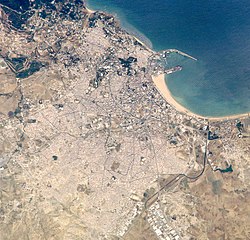
Central Tangier lies about 23 km (14 mi) east of Cape Spartel, the southern half of the Strait of Gibraltar.[51] It nestles between two hills at the northwest end of the Bay of Tangier, which historically formed the best natural harbour anywhere on the Moroccan coast before the increasing size of ships required anchorage to be made further and further from shore.[51] The shape of the gradually-rising underlying terrain creates the effect of the city as an amphitheatre, with the commercial district in the middle.[51] The western hill (French: La Montagne) is the site of the city's citadel or kasbah. The eastern hill forms Cape Malabata,[15] sometimes proposed as the point for a strait crossing.[72] (Years of studies have, however, made no real progress thus far.)[73]
The Marshan is a plateau about 1,189 metres (3,900 ft) long spreading west of downtown along the sea.[15]
Climate
Tangier has a mediterranean climate (Köppen Csa) with heavier rainfall than most parts of North Africa and nearby areas on the Iberian Peninsula owing to its exposed location.[74] The prevailing winds blow from the sea and have kept the site generally healthy even in earlier times with much poorer sanitation.[28] The summers are relatively hot and sunny and the winters are wet and mild. Frost is rare, although a new low of −4.2 °C (24.4 °F) was recorded in January 2005.[74]
| Climate data for Tangier ( Tangier Airport ) 1961–1990, extremes 1917–1963
| |||||||||||||
|---|---|---|---|---|---|---|---|---|---|---|---|---|---|
| Month | Jan | Feb | Mar | Apr | May | Jun | Jul | Aug | Sep | Oct | Nov | Dec | Year |
| Record high °C (°F) | 22.0 (71.6) |
24.1 (75.4) |
24.0 (75.2) |
29.1 (84.4) |
31.9 (89.4) |
33.5 (92.3) |
36.7 (98.1) |
38.2 (100.8) |
35.8 (96.4) |
30.4 (86.7) |
27.0 (80.6) |
24.0 (75.2) |
38.2 (100.8) |
| Mean daily maximum °C (°F) | 16.2 (61.2) |
16.8 (62.2) |
17.9 (64.2) |
19.2 (66.6) |
21.9 (71.4) |
24.9 (76.8) |
28.3 (82.9) |
28.6 (83.5) |
27.3 (81.1) |
23.7 (74.7) |
19.6 (67.3) |
17.0 (62.6) |
21.8 (71.2) |
| Daily mean °C (°F) | 12.5 (54.5) |
13.1 (55.6) |
14.0 (57.2) |
15.2 (59.4) |
17.7 (63.9) |
20.6 (69.1) |
23.5 (74.3) |
23.9 (75.0) |
22.8 (73.0) |
19.7 (67.5) |
15.9 (60.6) |
13.3 (55.9) |
17.7 (63.9) |
| Mean daily minimum °C (°F) | 8.8 (47.8) |
9.4 (48.9) |
10.1 (50.2) |
11.2 (52.2) |
13.4 (56.1) |
16.2 (61.2) |
18.7 (65.7) |
19.1 (66.4) |
18.3 (64.9) |
15.6 (60.1) |
12.2 (54.0) |
9.7 (49.5) |
13.6 (56.5) |
| Record low °C (°F) | −4.2 (24.4) |
0.8 (33.4) |
4.2 (39.6) |
5.8 (42.4) |
7.4 (45.3) |
10.2 (50.4) |
10.5 (50.9) |
14.0 (57.2) |
10.0 (50.0) |
9.0 (48.2) |
4.8 (40.6) |
−0.1 (31.8) |
−4.2 (24.4) |
| Average precipitation mm (inches) | 103.5 (4.07) |
98.7 (3.89) |
71.8 (2.83) |
62.2 (2.45) |
37.3 (1.47) |
13.9 (0.55) |
2.1 (0.08) |
2.5 (0.10) |
14.9 (0.59) |
65.1 (2.56) |
134.6 (5.30) |
129.3 (5.09) |
735.9 (28.97) |
| Average precipitation days | 11.2 | 11.4 | 10.1 | 9.3 | 6.1 | 3.7 | 0.8 | 0.8 | 3.1 | 8.0 | 11.1 | 12.0 | 87.6 |
| Average relative humidity (%)
|
80 | 81 | 78 | 78 | 76 | 74 | 70 | 72 | 73 | 76 | 79 | 81 | 76 |
| Mean monthly sunshine hours | 169.2 | 166.9 | 231.7 | 251.7 | 298.9 | 306.8 | 344.0 | 330.7 | 275.6 | 238.2 | 180.6 | 166.9 | 2,960.7 |
| Source 1: NOAA[75] | |||||||||||||
| Source 2: Deutscher Wetterdienst (humidity, 1973–1993)[76] | |||||||||||||
Subdivisions
The current prefecture is divided administratively into the following:[77]
| Name | Geographic code | Type | Households | Population (2004) | Foreign population | Moroccan population | Notes |
|---|---|---|---|---|---|---|---|
Assilah |
511.01.01. | Municipality | 6,245 | 28,217 | 66 | 28,151 | |
| Bni Makada | 511.01.03. | Arrondissement | 47,384 | 238,382 | 74 | 238,308 | |
| Charf-Mghogha | 511.01.05. | Arrondissement | 30,036 | 141,987 | 342 | 141,645 | |
| Charf-Souani | 511.01.06. | Arrondissement | 25,948 | 115,839 | 273 | 115,566 | |
| Tanger-Medina | 511.01.07. | Arrondissement | 40,929 | 173,477 | 2,323 | 171,154 | |
| Al Manzla | 511.03.01. | Rural commune | 555 | 3,031 | 0 | 3,031 | |
| Aquouass Briech | 511.03.03. | Rural commune | 787 | 4,132 | 3 | 4,129 | |
| Azzinate | 511.03.05. | Rural commune | 920 | 4,895 | 0 | 4,895 | |
| Dar Chaoui | 511.03.07. | Rural commune | 877 | 4,495 | 0 | 4,495 | 1,424 residents live in the centre, called Dar Chaoui; 3,071 residents live in rural areas. |
| Lkhaloua | 511.03.09. | Rural commune | 2,405 | 12,946 | 1 | 12,945 | |
| Sahel Chamali | 511.03.11. | Rural commune | 1,087 | 5,588 | 2 | 5,586 | |
| Sidi Lyamani | 511.03.13. | Rural commune | 1,883 | 10,895 | 1 | 10,894 | 1,101 residents live in the centre, called Sidi Lyamani; 9,794 residents live in rural areas. |
| Boukhalef | 511.81.03. | Rural commune | 3,657 | 18,699 | 4 | 18,695 | 3,187 residents live in the centre, called Gueznaia; 15,512 residents live in rural areas. |
Economy
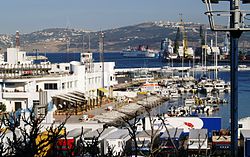
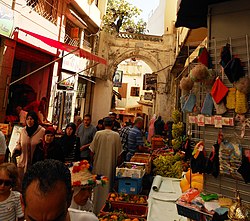
Tangier is Morocco's second most important industrial centre after
Tangier's economy relies heavily on tourism. In the 1960s and '70s, Tangier formed part of the hippie trail.[78] It became less popular and tourist attractions became run-down as cheap flights made central Moroccan cities like Marrakesh more accessible to European tourists; crime rose and a somewhat dangerous reputation drove more tourists away.[78] Since 2010, however, King Mohammed VI has made a point of restoring the city's shipping and tourist facilities and improving its industrial base. Among other improvements, the beach was cleaned and lined with new cafes and clubs; the new commercial port means cruise ships no longer unload beside cargo containers.[78]
Seaside resorts have been increasing with projects funded by foreign investments.
Tanger-Med, a new port 40 km (25 mi) outside Tangier proper, began construction in 2004 and became functional in 2007. Its site plays a key role in connecting maritime regions, as it is in a very critical position on the Strait of Gibraltar, which passes between Europe and Africa. The makeup of the new port is 85% transhipment 15% for domestic import and export activities.[79] The port is distinguished by its size, infrastructure, and efficiency in managing the flow of ships. Tanger-Med has linked Morocco to Europe's freight industry. It has also helped connect Morocco to countries in the Mediterranean, Africa, and America. The port has allowed Tangier to become a more globalised city with new international opportunities that will help facilitate economic growth.[80] The construction and operation of the port aimed to create 120,000 new jobs, 20,000 at the port and 100,000 resulting from growing economic activity.
Artisanal trade in the medina ("Old City") specialises mainly in
The city has grown quickly due to
In 2023 Tangier hosted the Connect route development forum.[83][84]
Notable landmarks



The old town is still surrounded by the remains of what was once more than 1,829 metres (6,000 ft) of stone rampart. Most of it dates to the town's Portuguese occupation, with restoration work later undertaken at different times. Three major bastions were the Irish Tower (Bordj al-Naʿam), York Castle (Bordj dar al-Barud), and the Bordj al-Salam.[15]
- Medina (old city)
- Kasbah Palace, former residence of the governors of Tangier, built on the site of the former English Upper Castle,[15] now Museum of Mediterranean Cultures
- Kasbah Mosque
- Purported tomb of Ibn Battuta
- Petit Socco, central square of the lower (southern) section of the medina
- Rue Es-Siaghine leading to the Petit Socco
- Dar Niaba
- Church of the Immaculate Conception
- Grand Mosque of Tangier
- Hotel Continental
- Beit Yehuda Synagogue
- Former American Legation
- Fondation Lorin
- Musée de Carmen-Macein
- Extra-muros downtown
- Lalla Abla Mosque on the port
- Grand Socco, former marketplace and central city square outside the old city walls
- Mendoubia palace, now a museum of Moroccan resistance against colonialism, and its surrounding park on former cemeteries
- Sidi Bou Abib Mosque
- St Andrew's Church
- Museum of Contemporary Art in the former British Consulate
- Roman Catholic Cathedral of Tangier
- Abdelhafid Palace
- Mohammed V Mosque
- French Consulate General at the start of Boulevard Pasteur
- Moroccan Debt Administration building, now tourist office
- Gran Teatro Cervantes
- French Church of Tangier
- Villa Muniria
- Marshan neighborhood
- Further outskirts
Transport

The
The new
Tangier's
Education
Tangier offers four types of education systems: Arabic, French, Spanish and English. Each offers classes starting from pre-Kindergarten up to the 12th grade, as for German in the three last years of high school. The Baccalauréat, or high school diploma are the diplomas offered after clearing the 12 grades.
Many universities are inside and outside the city. Universities like the Institut Supérieur International de Tourisme (ISIT), which grants diplomas, offer courses ranging from
Primary education
There are more than a hundred Moroccan primary schools, dispersed across the city. Private and public schools, they offer education in Arabic, French and some school English until the 5th grade. Mathematics, Arts, Science Activities and nonreligious modules are commonly taught in the primary school.
International primary institutions
- American School of Tangier
- École Adrien Berchet (French primary school)
- Groupe scolaire Le Détroit(French school)
- Colegio Ramón y Cajal (Spanish primary school)
- English College of Tangier
International high schools
- American School of Tangier
- Lycée Regnault de Tanger(French high school)
- Groupe scolaire Le Détroit(French school)
- Instituto Español Severo Ochoa (Spanish high school)
- English College of Tangier
- Mohammed Fatih Turkish School of Tangier
- Tangier Anglo Moroccan School
Culture


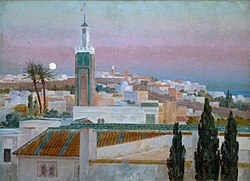
Never in my life have I observed anything more bizarre than the first sight of Tangier. It is a tale out of the
Thousand and One Nights... A prodigious mix of races and costumes...This whole world moves about with an activity that seems feverish.
When
The multicultural placement of
In the 1940s and until 1956 when the city was an
Around the same time, a circle of writers emerged which was to have a profound and lasting literary influence. This included
After several years of gradual disentanglement from Spanish and French colonial control, Morocco reintegrated the city of Tangier at the signing of the
Language
Most of the inhabitants of Tangier speak a very distinctive variety of Moroccan Arabic which differs from other Darija counterparts. The difference resides in pronunciation, tempo, grammar and a unique vocabulary. Arabic is used in government documentation and on road signs together with French. French is taught in primary schools and high schools and used in universities and large businesses. Spanish is well understood and spoken fluently, mainly exclusively by Tangierian locals. English, on the other hand, has been and still is used in tourist sectors.
The autochthonous population of Tangier has been declining drastically since the mid 2000s, as many locals, especially those from the younger generations, have moved to nearby Spain. While the industrial sector is expanding constantly, the internal immigration from the south to north is increasing rapidly. As a consequence, the Tangierian dialect is losing its distinctiveness or is being altered (in a recent study, social media has been depicted as one of these factors).
Nowadays, the Tangierian dialect is less prominent in public places, with the southern Darija dialect being more common in the area, to the extent that some observers question if Tangier retains its identity as it was before.
Religion

Due to its Christian past before the Muslim conquest, it remains a
Towards the end of the 3rd century, Tangier was the scene of the martyrdoms of St. Marcellus, mentioned in the Roman Martyrology on 30 October, and of St. Cassian, mentioned on 3 December.[4]
Under the Portuguese, the

The city also has the Anglican
Jews have a
Sport
Tangierians regard football as the primary entertainment when it comes to sport-material. There are several football fields around the city. Tangier would have been one of the host cities for the 2015 Africa Cup of Nations football tournament, which would be played at the new Ibn Batouta Stadium and in other cities across Morocco, until Morocco was banned from participating the Africa Cup of Nations due to their denial.[93] Instead Tangier will host matches for the 2025 edition after Guinea withdraw from hosting. It could also host matches for the 2030 FIFA World Cup.
Basketball comes the second most practised sport in Tangier. The city is known for their local teams IRT, Ajax Tanger, Juventus Tangier and so on.
Museums
The Museum of the American Legation, whose building was granted to the United States in 1821 by the Sultan Moulay Suliman served as a consulate of the United States and a later legation, as well as a high traffic post for the intelligence agents of the Second World War and a Peace Corps training facility. Today, its courtyards and narrow corridors serve as an elaborate museum that demonstrates relations between the United States and Morocco and the Moroccan heritage, including a wing dedicated to Paul Bowles, where you can see the documents and photographs of the writer donated to the museum by the gallerist and friend of the writer Gloria Kirby in 2010.[94]
Fondation Lorin (Musée de la Fondation Lorin) opened in 1930 in a former synagogue. In addition to art, there are newspapers, photographs and posters on display.[95]
In popular culture
Espionage
Tangier has been reputed as a
and during other spying periods of the 19th and 20th centuries is legendary.Tangier acquired the reputation of a spying and smuggling centre and attracted foreign capital due to political neutrality and commercial liberty at that time. It was via a British bank in Tangier that the Bank of England in 1943 for the first time obtained samples of the high-quality forged British currency produced by the Nazis in "Operation Bernhard".
The city has also been a subject for many spy fiction books and films.
Notable people
- Ibn Battuta (1304–1378), Moroccan scholar and traveler who went on a worldwide quest.[97]
- Roger Elliott (c. 1665–1714), first British Governor of Gibraltar
- Alexander Spotswood (1676–1740), American Lieutenant-Colonel and Lieutenant Governor of Virginia.[98]
- Ion Hanford Perdicaris (1840-1925), Greek-American author, lawyer and painter; he became the unofficial head of Tangier's foreign community
- Alexandre Rey Colaço (1854-1928), Portuguese pianist
- Walter Burton Harris (1866–1933), journalist, writer, traveller and socialite
- Heinz Tietjen (1881–1967), German music composer
- Abdullah al-Ghumari (1910–1993), Muslim cleric, scholar of hadith, jurist and theologian
- Paul Bowles (1910–1999), American writer, composer and ethnomusicologist
- William S. Burroughs (1914–1997), Beat Generation writer, wrote Naked Lunch during the 1950s in Tangier.
- Abderrahmane Youssoufi (1924–2020), former Prime Minister of Morocco
- Ahmed Yacoubi (1928–1985), international painter and storyteller
- Claude-Jean Philippe (1933–2016), French film critic
- Emmanuel Hocquard (1940–2019), French poet
- Jean-Luc Mélenchon (born 1951), French politician, currently MEP
- Ralph Benmergui (born 1955), Canadian TV and radio host at the Canadian Broadcasting Corporation
- Helena Maleno (born 1970), human rights defender, journalist and writer
- Karim Debbagh (born 1972), Moroccan film producer
- Yasser Harrak (born c. 1975), writer and human rights activist.
- Sanaa Hamri (born 1977), Moroccan music video director.
- Ali Boussaboun (born 1979), former international footballer with 12 caps for Morocco
- Zakaria Ramhani (born 1983), visual artist
Twin towns – sister cities
Gallery
-
Panoramic view of Tangier
-
Old tribunal,Kasbah Mosque, Kasbah Palace entrance and Bayt al-mal(treasury), c. 1900
-
Former palace entrance, treasury and prison, 2015
-
Jewish Cemetery
-
Souk
-
City walls
See also
- History of Morocco
- List of cities in Morocco
- Tingis & Mauretania Tingitana
- List of Colonial Heads of Tangier
- English Tangier
- Tangier International Zone
References
Citations
- ^ High Commission for Planning. 20 March 2015. p. 8. Retrieved 9 October 2017.
- ^ Ghaki (2015), p. 67.
- ^ a b Head et al. (1911).
- ^ a b c d e f g h i Cath. Enc. (1913).
- ISBN 978-92-3-102376-7.
- ^ Ruiz (2012), p. 208.
- ^ Ahmed Toufiq (2019). في تاريخ المغرب [On the History of Morocco] (in Arabic).
- ^ a b c d Hartley (2007), p. 345.
- ^ a b Davies (2009), p. 119.
- ^ a b Roller (2006), p. 34.
- ^ Gómez Bellard, Carlos; et al. (January 2008), "Rural Landscapes of the Punic World", Monographs in Mediterranean Archaeology, London: Equinox, Ch. 5, p. 17.
- ^ Meakin (1899), p. 10.
- ^ Amitay (2011).
- ^ a b L. Mestrius Plutarchus, "15: Sertorius", Parallel Lives, §9.
- ^ a b c d e f g h i Lévi-Provençal (1936), p. 650.
- ^ a b c Encyclopædia Britannica (1878).
- ^ a b Procopius, History of the Wars, Bk. III.
- ^ a b c d e f g Finlayson (1992), p. 26.
- ^ Meakin, James Edward Budgett; Meakin, Kate Alberta (1911). . In Chisholm, Hugh (ed.). Encyclopædia Britannica. Vol. 18 (11th ed.). Cambridge University Press. pp. 850–861, see page 855, final two lines.
In the fifth century A.D. the country became subject to the Vandals and, about 618, to the Goths.
- ^ Akram (1980), p. 5.
- ^ a b Collins (2003).
- ^ Akram (1980), p. 9.
- ^ a b Gerli (2003).
- ^ Brett (2017).
- ^ Ibn Abd al-Hakam (1922), Torrey, Charles Cutler (ed.), The History of the Conquest of Egypt, North Africa, and Spain..., New Haven: Yale University Press.
- ^ Civantos (2017), p. 115.
- ^ Benabbès, Ahmed (2005), "Les Premiers Raids Arabes en Numidie Byzantine: Questions Toponymiques", Identités et Cultures dans l'Algérie Antique, Rouen: University of Rouen. (in French)
- ^ a b c Baedeker (1901), p. 426.
- ^ a b c Brett (2017), p. 193.
- ^ Ilahiane (2010), s.v. "Barghwata".
- ^ Brett (2017), p. 194.
- ^ Blankinship (1994), pp. 208–9.
- ^ a b c d e f g h i j k l m n o p q r Lévi-Provençal (1936), p. 651.
- ^ Ilahiane (2010), s.v. "Ibn Battuta Muhammad ibn ʿAbd Allah".
- ^ Elbl (2012).
- ^ B. W. Diffie, Prelude to Empire, Portugal Overseas before Henry the Navigator, University of Nebraska Press, Ann Arbor, 1960, pp. 83–90.
- ^ Elbl (2013), p. 10.
- ^ Winston S. Churchill, Marlborough: His Life and Times, Book I (University of Chicago Press: Chicago, 1933) p. 35.
- ^ Elbl (2013), p. 12.
- ^ Elbl (2013), pp. 12–13.
- ^ Finlayson (1992), pp. 26–27.
- ^ Articles of Peace Concluded and Agreed between His Excellency the Lord Bellasyse, His Majesties Governour of His City and Garrison of Tangier in Affrica, &c. and Cidi Hamlet Hader Ben Ali Gayland, Prince of VVest-Barbary, &c., London, 2 April 1666.
- .
- ^ Routh (1912).
- ^ Elbl (2009).
- ^ Elbl (2013), Ch. 8.
- ^ a b c Finlayson (1992), p. 28.
- ^ Elbl (2013), pp. 13–14.
- ^ Finlayson (1992), p. 31.
- ^ a b Lévi-Provençal (1936), p. 652.
- ^ a b c d e f g h i Encyclopædia Britannica (1911).
- ^ Power, Faith and Fantasy: In the beginning, for America, was the Middle East Archived 2007-04-03 at the Wayback Machine, Matt Buckingham, week, February 14, 2007.
- ^ Meakin, James Edward Budgett; Meakin, Kate Alberta (1911). . In Chisholm, Hugh (ed.). Encyclopædia Britannica. Vol. 18 (11th ed.). Cambridge University Press. pp. 850–861, see page 857, final para.
By Sulaiman's direction the imperial umbrella passed to his nephew, Abd-er-Rahman II., on whom he could rely to maintain his policy. Although disposed to promote foreign trade, he made a futile attempt in 1828 to revive piracy, which the Austrians frustrated by reprisals next year.
- ^ Elbl (2013), p. 15.
- ISBN 978-2-922505-21-4.
- ^ a b c Abdulrazak, Fawzi A. (1990). The kingdom of the book: The history of printing as an agency of change in Morocco between 1865 and 1912. Boston University (PhD thesis). pp. 141–142.
- ^ ISBN 978-0-521-81070-8.
- ^ Richard Pennell (2003), Morocco: From Empire to Independence, Oxford: Oneworld, p. 140
- ^ "Ruta por el Tánger histórico". Guía de Marruecos. 2020-03-10.
- ^ "Palais Moulay Hafid". Hotel Tanger. 2 April 2013.
- ^ "New Status of Tangiers", The Times of London, November 27, 1923.
- ^ League of Nations Treaty Series, vol. 28, pp. 542–631.
- ISBN 978-1-84511-081-9, retrieved 2023-04-18
- ^ <Ceballos, Leopoldo, Historia de Tánger, Almuzara, 2009, pp. 10-11 and 23-24>
- ^ Payne, S.G. (1987). The Franco Regime, 1936–1975. Madison: University of Wisconsin. p. 268.
- ^ Payne 1987, p. 274, note 28.
- ^ Benton, Assistant Secretary (October 21, 1945). "Reestablishment of the International Regime in Tangier". Department of State Bulletin. 330. XIII: 613–618.
- ^ ISBN 978-1-5036-0900-6, retrieved 2024-03-20, page 20.
- ISBN 978-1-5036-0900-6, retrieved 2024-03-20, page 17
- ^ "Final Declaration of the International Conference in Tangier and annexed Protocol. Signed at Tangier, on 29 October 1956 [1957] UNTSer 130; 263 UNTS 165". 1956.
- ^ "Tangier(s)", Jewish Virtual Library, archived from the original on 18 January 2012.
- ^ Tremlett, Giles (15 December 2003), "Spain and Morocco Plan Tunnel Link", The Guardian.
- ^ Leadbeater, Chris (31 May 2018), "Will a Tunnel from Spain to Africa Ever Be Built—And Who Would Use It?", The Telegraph, archived from the original on December 19, 2000.
- ^ a b Valor, G. Ballester. "Synop report summary".
- ^ "Tangier Climate Normals 1961–1990". National Oceanic and Atmospheric Administration. Retrieved October 14, 2016.
- ^ "Klimatafel von Tanger / Marokko" (PDF). Baseline climate means (1961–1990) from stations all over the world (in German). Deutscher Wetterdienst. Retrieved October 14, 2016.
- ^ "Recensement général de la population et de l'habitat de 2004" (PDF). Haut-commissariat au Plan, Lavieeco.com. Archived from the original (PDF) on 8 April 2019. Retrieved 27 April 2012.
- ^ a b c Davies (2009), p. 120.
- ^ César Ducruet, Fatima Mohamed-Chérif, Najib Cherfaoui. Maghreb Port Cities in Transition: The Case of Tangier (n.d.): n. pag. Web.
- ^ Ouail El Im Rani Et Al., International Journal of Research in Management, Economics and Commerce, ISSN 2250-057X, Impact Factor: 6.384, Volume 06 Issue 07, July 2016, Page 73-81. Tangier Med Port: What Role for the Moroccan Economy and the International Trade? (n.d.): n. page. Web.
- ^ Meakin (1901), p. 107.
- ^ Hume (1913), p. 101.
- ^ Greenbank, Chloe (22 February 2023). "Airports and airlines connect in Tangier". Regional Gateway. Retrieved 28 March 2023.
- ^ "Tourism: Morocco's big bet for 2023". Atalayar.
- ISBN 978-1-85709-575-3.
- ^ Wellington, Hubert, ed. (1980), The Journal of Eugène Delacroix, Cornell University Press, p. xv.
- ^ Prodger, Michael (5 February 2016). "Damnation, Dante and Decadence: Why Eugène Delacroix is making a hero's return". The Guardian. Retrieved 30 April 2016.
- ^ The American Legation at Tangier, Morocco Archived January 24, 2008, at the Wayback Machine
- ^ Annuario Pontificio 2010, p. 721
- ^ "MOROCCO 2018 INTERNATIONAL RELIGIOUS FREEDOM REPORT" (PDF). Archived (PDF) from the original on 2021-04-02. Retrieved 2021-01-12.
- ^ Alami, Aida (29 March 2019). "Pope Francis' Visit to Morocco Raises Hopes for Its Christians". The New York Times. Archived from the original on 2019-10-01. Retrieved 2021-01-12.
- ^ "Jewish in Morocco". Archived from the original on 2019-04-02. Retrieved 2021-01-12.
- ^ Morocco then South Africa to host Cups. FIFA.com (2011-01-29). Retrieved on 2011-06-04.
- ^ "PAUL BOWLES WING: Tangier American Legation (TALIM)". www.paulbowles.org. Archived from the original on 2019-12-27. Retrieved 2019-03-27.
- ^ "Visit Africa's Tangier City, Morocco". visitafrica.site. Retrieved 2021-04-24.
- ISBN 978-1-85065-426-1.
- ^ Yule, Henry; Beazley, Charles Raymond (1911). . Encyclopædia Britannica. Vol. 14 (11th ed.). pp. 219–220.
- ^ . Encyclopædia Britannica. Vol. 25 (11th ed.). 1911. p. 735.
- ^ "Un jumelage Tanger - Phuket (Thaïlande) en projet". bladi.net (in French). 2016-02-19. Retrieved 2020-10-19.
- ^ "Algeciras y Tánger, hermanadas en políticas turísticas y culturales". lavozdigital.es (in Spanish). La Voz de Cádiz. 2018-09-24. Retrieved 2020-10-19.
- ^ "Tanger et Da Nang liées par un accord de jumelage". lematin.ma (in French). Le Matin. 2019-03-29. Retrieved 2020-10-19.
- ^ "Jumelage et Pactes d'amitié". puteaux.fr (in French). Puteaux. Retrieved 2020-10-22.
- ^ "Decentralized international cooperation". saint-josse.irisnet.be. Saint-Josse-ten-Noode. 2019-05-21. Retrieved 2020-10-19.
General bibliography
- . Encyclopædia Britannica, Ninth Edition. Vol. XXIII. p. 46 – via Wikisource.
- . Encyclopædia Britannica. Vol. 26 (11th ed.). 1911. pp. 397–398.
- Akram, Agha Ibrahim (1980), The Muslim Conquest of Spain, Rawalpindi: Army Education Press.
- Amitay, Ory (2011), "Procopius of Caesarea and the Girgashite Diaspora", Journal for the Study of the Pseudoepigrapha, vol. 20, No. 4, pp. 257–276, CiteSeerX 10.1.1.878.3222.
- Baedeker, Karl (1901), "Tangier", Spain and Portugal: Handbook for Travellers (2nd ed.), Leipzig: Karl Baedeker.
- Blankinship, Khalid Yahya (1994), The End of the Jihad State, Albany: SUNY Press, ISBN 978-0-7914-1827-7.
- Brett, Michael (2017), "Conversion of the Berbers to Islam", Islamisation: Comparative Perspectives from History, Edinburgh: Edinburgh University Press, pp. 189–198, ISBN 9781474417136.
- Civantos, Christina (2017), The Afterlife of al-Andalus: Muslim Iberia in Contemporary Arab and Hispanic Narratives, Albany: State University of New York Press, ISBN 9781438466712.
- Collins, Roger (2003), Count Julian, Taylor & Francis, ISBN 9780415939188.
- Davies, Ethel (2009), "Tangier", North Africa: The Roman Coast, Chalfont St Peter: Bradt Travel Guides, pp. 119 ff, ISBN 9781841622873.
- Elbl, Martin Malcolm (2009), "(Re)claiming Walls: The Fortified Médina of Tangier under Portuguese Rule (1471–1661) and as a Modern Heritage Artefact", Portuguese Studies Review, pp. 103–192.
- Elbl, Martin Malcolm (2012), "Tangier's Qasba Before the Trace Italienne Citadel of 1558–1566: The 'Virtual' Archaeology of a Vanished Islamic and Portuguese Fortress", Portuguese Studies Review, pp. 1–44.
- Elbl, Martin Malcolm (2013), Portuguese Tangier (1471–1662): Colonial Urban Fabric as Cross-Cultural Skeleton, Peterborough: Baywolf Press, ISBN 9780921437505.
- Elbl, Martin Malcolm (2021), "A Tale of Two Breakwaters: Modelling Portuguese and English Works in the Port of Tangier Bathymetric Space — 1500s–1683" Portuguese Studies Review, vol. No. 29, pp. 55–136.
- Finlayson, Iain (1992), Tangier: City of the Dream, London: Tauris Parke, ISBN 9781780769264.
- Gerli, E. Michael (2003), "Mūsā ibn Nusayr", Medieval Iberia, New York: Routledge, ISBN 9780415939188.
- Ghaki, Mansour (2015), "Toponymie et Onomastique Libyques: L'Apport de l'Écriture Punique/Néopunique" (PDF), La Lingua nella Vita e la Vita della Lingua: Itinerari e Percorsi degli Studi Berberi, Studi Africanistici: Quaderni di Studi Berberi e Libico-Berberi, Naples: Unior, pp. 65–71, ISSN 2283-5636, archived from the original(PDF) on 2020-04-28, retrieved 2018-11-07. (in French)
- Haller, Dieter (2021). Tangier/Gibraltar: A Tale of One City—An Ethnography. Bielefeld: Transcript.
- Hartley, James (2007), "Tangier", Cities of the Middle East and North Africa, ISBN 9781576079195.
- Head, Barclay; et al. (1911), "Mauretania", Historia Numorum (2nd ed.), Oxford: Clarendon Press, pp. 887 ff.
- Hume, H. Harold (1913), Citrus Fruits and Their Culture, New York: O. Judd Co.
- Ilahiane, Hsain (2010), Historical Dictionary of the Berbers (2nd ed.), Lanham: Rowman & Littlefeld, ISBN 9781442281820.
- Lévi-Provençal, Évariste (1936), "Tangier", Encyclopaedia of Islam, vol. IV, Leiden: E.J. Brill, pp. 650–652.
- Meakin, Budgett (1899), The Moorish Empire, London: Swan Sonnenschein & Co.
- Meakin, Budgett (1901), The Land of the Moors: A Comprehensive Description, London: Swan Sonnenschein & Co.
- Pétridés, Sophron (1913), "Tingis", Catholic Encyclopedia, vol. XIV, New York: Encyclopedia Press.
- Roller, Duane W. (2006), Through the Pillars of Herakles: Greco-Roman Exploration of the Atlantic, Abington: Routledge, ISBN 9781134192328.
- Routh, Enid M.G. (1912), Tangier: England's Lost Atlantic Outpost, London: John Murray.
- Ruiz, Ana (2012), Medina Mayrit: The Origins of Madrid, New York: Algora Publishing, ISBN 9780875869254.
External links
- Official site of The Tangier American Legation Institute for Moroccan Studies
- History, description, and images of Tangier on Archnet
- Tangier photo gallery
- Navigating Tangier's Labyrinth – slideshow by The New York Times
- "Tangier". Islamic Cultural Heritage Database. Istanbul: Organisation of Islamic Cooperation, Research Centre for Islamic History, Art and Culture. Archived from the original on 2013-04-27.
- Tangier on Archnet – History, sites, photos (historic and contemporary), and media
- Old maps of Tangier, Historic Cities site

